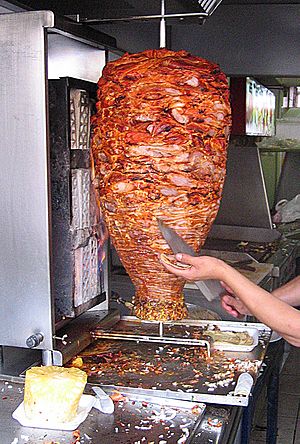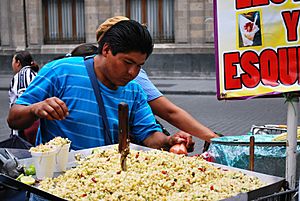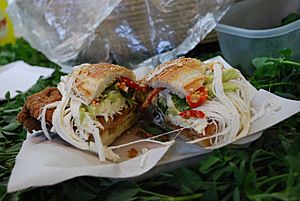Mexican street food facts for kids
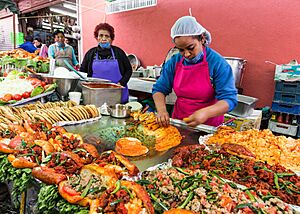
Mexican street food, often called antojitos (which means "little cravings"), is super popular in Mexico. You'll find these tasty treats sold by people on the street and in busy traditional markets.
Some of the most common street foods include tacos, tamales, gorditas, quesadillas, tostadas, chalupas, and tortas (like sandwiches). You can also find fresh fruit, vegetables, drinks, and yummy soups like menudo and pozole. Most of these foods are sold in the morning and evening, because the main meal of the day (called comida) is usually eaten in the mid-afternoon.
Mexico has one of the biggest street food scenes in Latin America. In fact, Forbes magazine even said that Mexico City is one of the best places in the world to enjoy street food!
Contents
What are Antojitos?
In Mexico, fast foods sold on the streets and in market stalls are known as antojitos. This name means "little cravings" because these foods are usually snacks, not part of a big, formal meal. You'll find them most easily in the early morning, evening, and late into the night.
Most Mexican street food is made with corn products. The best places to find these delicious foods are often near markets and public transport stops. In Mexico City, you can also find them in special street markets called "tianguis."
Some people visiting Mexico worry about eating street food because of health concerns. But by avoiding it, they miss out on some of the best Mexican dishes! A good tip for finding safe street food is to look for a busy stall. If lots of local people are buying food there, it usually means the food is fresh and tasty. It's also a good sign if the cook isn't handling money.
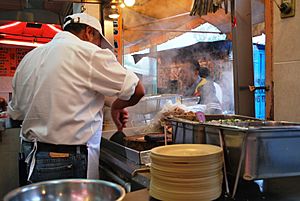
Mexico's street food culture is huge in Latin America. About 43% of people in Mexico think street food is safe, and around 58% eat it at least once a week! Mexican food is so important that UNESCO has even called it an "intangible cultural heritage" for all of humanity.
Street food has even influenced fancy restaurants in Mexico. Many upscale places now serve dishes that started on the streets, sometimes with a special twist. Mexican street food has also become popular in other countries, especially in the United States. In cities like Los Angeles, you can find many Mexican-style street food trucks selling tacos, tortas, and quesadillas. Tacos are so famous in Los Angeles that they're like the city's signature dish!
Types of Mexican Street Food
Tacos
The taco is probably the most famous Mexican street food, and it was one of the first to become popular in the United States. A taco is simply a folded tortilla with a yummy filling inside. The fillings can be very different depending on where you are in Mexico.
Most tacos are made with corn tortillas. But in the very north of Mexico, people often use wheat flour tortillas. The tortillas in Mexican tacos are usually soft. Sometimes, the whole taco is fried, which is called "dorado" (meaning "golden").
Tacos have a long history, going back to ancient times when people used tortillas to scoop up other foods. Modern tacos became popular in the countryside when wives would wrap meals in tortillas for their husbands working in the fields. When many people moved to cities in the 20th century, taco stands started selling these familiar foods. Mexico City is especially famous for its tacos, offering specialties from almost every part of the country. Tacos are loved by everyone in Mexico, no matter their background!
Taco fillings are super varied, and most taco sellers have their own special kind. Some of the most well-known are al pastor and bistek (steak). For the brave eaters, there are even tacos with beef eyes, brains, or tongue!
Taco vendors often use a big wooden block called a tronco to chop up meat and other fillings with a large knife. Tacos usually come with toppings like chopped onion, cilantro, different salsas, grilled green onions, and lime wedges.
Some tacos are only available in the morning. These include tacos de canasta (basket tacos), barbacoa, or cabeza de res (beef head).
- Tacos de canasta are unique because they aren't made on the spot. They have fillings like potatoes and chorizo sausage, pork rind, beans, or spiced ground meat. They are steamed and kept warm in a basket.
- Barbacoa is meat (often mutton) that's slow-cooked in a pit.
- Cabeza de res tacos are made from different parts of a steer's head.
These morning taco vendors often sell out and close by midday.
In the late afternoon and evening, especially on weekends, other taco stalls open with different choices, mainly grilled, fried, or steamed meats. A famous evening taco in Mexico City is tacos al pastor (shepherd-style tacos). These were inspired by Middle Eastern spit-cooked meat, brought by immigrants. But instead of lamb, they use pork seasoned with mild chili peppers, onions, and pineapple.
Other taco types include:
- Tacos de guisado or tacos de cazuela: These are filled with meat or vegetables in a sauce.
- Fritangas: Tacos with fried meat, like sausage.
- Carnitas: Pork cooked slowly in lard with orange rind for flavor. This was originally from Michoacán and Jalisco but is now found everywhere.
- Carne asada: Grilled meat tacos, especially popular in Sonora. It's beef grilled over charcoal, often mesquite.
- Fish tacos: A specialty of Baja California and the Pacific coast, now very popular in the U.S.
- Flautas (also called taquitos or tacos dorados): These are filled tortillas that are rolled up and then fried until crispy. They are usually topped with cream, salsa, and veggies like lettuce, tomatoes, and onions.
Tamales
Tamales are another super popular street food. They have a filling wrapped in a corn-based dough called masa, and then steamed in corn husks. Tamales can be sweet or savory, spicy or mild. The most common ones have pork or chicken with salsa or mole sauce. Another popular version is 'rajas', which are strips of poblano chili pepper and cheese. Tamales are a good choice for new street food eaters because they are cooked and kept warm in a steam pot, making them very safe.
There are many regional types of tamales:
- Corundas are triangle-shaped tamales from Michoacán, wrapped in corn stalk leaves.
- Tamales from Chiapas have unique flavors, sometimes with ingredients like pibil, mole sauce, carrots, corn, egg, raisins, or almonds. Some are wrapped in banana leaves.
- Uchepos are tamales made with fresh corn, usually found in Michoacán in July and August.
Camotes
Camotes are traditional sweet potatoes cooked and sold on the streets, especially in Central and Southern Mexico. This food is closely linked to the Day of the Dead holiday, making it very important to Mexican culture.
Camotes are sweet potatoes that are pressure-cooked and served individually. They are traditionally topped with condensed milk and seasoned with chili peppers, cinnamon, or strawberry jam. Camote vendors are easy to spot because their cooking carts make a very loud, high-pitched whistle! You can often hear a camote vendor from blocks away in Mexico City. Even though they are traditional, camotes are mostly found in or around Mexico City and other big cities.
Other Delicious Foods
Many other street foods are made with tortillas:
- Tostadas are flat, crispy tortillas (fried or dried) topped with things like shredded chicken, pork, beef, seafood, cheese, and salsa.
- Quesadillas get their name from queso (cheese). They are tortillas folded in half and filled with cheese, and sometimes other ingredients like spicy meat, mushrooms, or chili strips. The type of cheese changes by region, and in some places, they don't even add cheese unless you ask!
- Empalmes are three stacked corn tortillas with beans and meat or stew, popular in Nuevo León.
- Sincronizadas are two corn tortillas with meat and cheese, toasted until the cheese melts.
- Gringas are similar to quesadillas but made with a flour tortilla.
- Tlayudas are large, dried tortillas from Oaxaca, topped with beans and other ingredients, like a big pizza or tostada.
Some street foods use the same corn dough as tortillas but are prepared differently:
- Gorditas are thick corn dough patties, fried or cooked on a comal (a traditional griddle). They are split open and filled with various ingredients.
- Bocoles are small, round gorditas popular in Hidalgo, Tamaulipas, Veracruz, and San Luis Potosí.
- Garnachas are thick tortillas filled with shredded pork and onion, topped with salsa, cheese, and a vinegar-chili sauce.
- Memelas (also called picadas) are long, thick corn dough tortillas mixed with fried pork rind and salsa, then topped with tomato sauce and chopped lettuce.
- Tlacoyos are very popular in Mexico City. They are long and usually made with blue corn dough, filled with a bean paste before being cooked.
- Chalupas are small, fried corn dough cups filled with cheese, beans, or stew, topped with salsa and chopped lettuce. They are most popular in Puebla.
- Huaraches are large, flat, and topped with chopped meat, beans, cheese, cream, and salsa.
- Sopes are flat and thick, shaped like disks, with pinched edges. They are topped with beans, salsa, and more.
Elote means fresh corn. It's served on the cob or as cut kernels. If it's on the cob, it's grilled or boiled, then covered with mayonnaise and sprinkled with chili powder, salt, cotija cheese, lime juice, and hot sauce. The cut kernels are usually served in a dish called esquites, with similar seasonings, and eaten with a spoon.
Fresh fruits and vegetables are also popular street foods. Fruit cups are common and change with the season. They often have watermelon, papaya, mango, orange, jicama, and cucumber. These are cut into spears or cubes and seasoned with lime juice, salt, and chili pepper powder. Jicama is a root vegetable that's often eaten raw. A jicaleta is a large slice of jicama on a stick, like a lollipop, which can be covered with sweet or savory powders, hot sauce, or lime juice.
European influences brought wheat breads, which led to new street foods:
- Tortas are rolls cut open to make thick sandwiches with various fillings. These can include refried beans, cheese, hot meats (like breaded chicken or pork), carnitas, or cold cuts, along with avocado, onions, and pickled jalapeños. Tortas can be served cold or warm.
- In Puebla, a similar sandwich is called a cemita, named after the special bread used.
- Pambazos are small tortas where the bread is often dipped in a chili sauce before being filled.
- Empanadas are flour or corn flour turnovers with a filling, which are then baked. In Hidalgo, they are called 'pastes', similar to English pasties.
Soups
Not all Mexican street foods are based on breads. Street stalls and markets also serve delicious soups and broths like menudo and pozole. Caldo de pollo is chicken soup, often with rice and chickpeas, and you can add oregano, onions, salt, lime juice, and chili peppers.
Beverages
Besides food, there are many popular street drinks:
- Aguas frescas are classic street drinks. They are often made with fruits like watermelon, mango, orange, or lime, mixed with water and sugar. Other types are made with rice (called horchata), coconut, or tamarind, as well as a hibiscus flower tea called agua de Jamaica.
- In the south of Mexico, fermented corn drinks like tejuino are popular. In Tabasco, Chiapas, and parts of the Yucatán Peninsula, a similar drink called pozol is often flavored with chocolate and served cold. Many popular street drinks can also be found in juice bars.
Images for kids
-
An 18th century painting of a buñuelos street vendor in Mexico.
-
A busy taco stand in Sevilla, Mexico City.
-
Tacos with carnitas, carne asada, and al pastor.
-
A tamale being sold in Reynosa, Tamaulipas.
See also
 In Spanish: Antojito para niños
In Spanish: Antojito para niños




